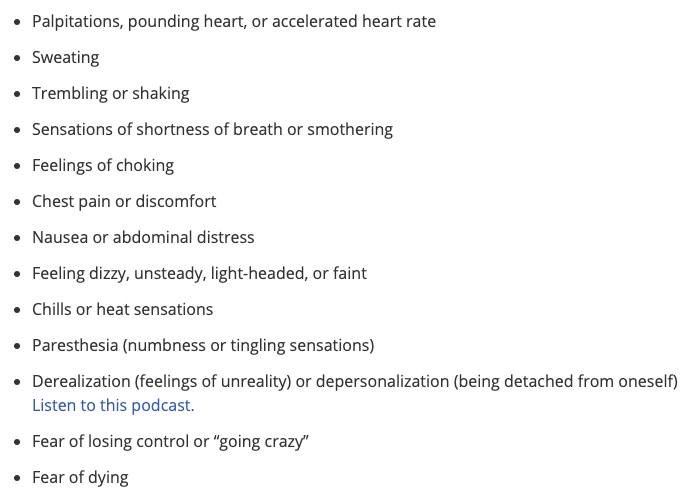Panic Attacks: Identifying and Surviving Emotional Crises
STAYING SAFE. Cited from the ADAA (Anxiety and Depression Association of America)’s website, the symptoms of panic attacks can vary hugely.
May 4, 2021
With finals right around the corner and students more stressed than ever before, finding good strategies to manage that stress is paramount. Most students are aware of generic stress relief strategies, such as sleeping well, meditating, or eating healthy. However, for many students these are simply not enough to prevent the occasional mental health crisis. It is therefore critical to know how to specifically address and conquer the most common type of mental health crisis: a panic attack.
Just what is a panic attack? Caused by a build up of stress or anxiety, a panic attack is essentially an emotional crisis. The ADAA (Anxiety and Depression Association of America) describes it as “the abrupt onset of intense fear or discomfort,” and notes that it is usually set off by specific criteria (most commonly certain actions or phrases), called triggers. During a panic attack, the mind becomes convinced that it is in mortal danger, accelerating heart and breathing rates dramatically, as well as causing feelings of intense dread, fear, and disassociation. Most people experiencing an attack for the first time actually call 911 under the illusion that they’re having a heart attack or are dying.
According to the ADAA, some additional symptoms of panic attacks may include:
- Palpitations, pounding heart, or accelerated heart rate
- Sweating and trembling
- Shortness of breath or smothering/ feelings of choking/ chest pain
- Nausea/ dizziness/ faintness
- Chills or feverish sensations/ numbness/ tingling
- Disassociation/ depersonalization (feeling detached from oneself)
- Feelings of losing control/ “going crazy” or “snapping”
- Feeling like one is dying
People with preexisting conditions– such as anxiety or panic disorders, PTSD or CPTSD, or other major illness, mental and physical– are also at much higher risk of suffering panic attacks than others. However, the reality is that anyone under severe stress can suffer a panic attack, and most people have at some point in their life, whether they realize it or not. Sadly, panic attacks are often educated about on the assumption that they will happen, rather than on the assumption that they might.
The one positive to panic attacks is that they are relatively short lived. The human body can only panic for about 20 minutes maximum, although it should be noted that one panic attack often triggers others, or may even cause an anxiety attack (a vague sense of dread, uneasiness, or irritability that can last many, many hours).
The first thing to do when a panic attack is identified is to get to a quiet, safe space. This will cut down on distractions and on-lookers, as well as give one the calm environment they need to bring oneself down from a panic. Most bathrooms will work just fine, as well as any charitable teacher’s room. Recently added to the St. Joe community specifically is a room in the counseling office where students are welcome at any time during the day to drop by and take care of their psychological/ emotional needs. An added bonus of using this room is the presence of the counselors nearby to talk with and offer support!
After securing a safe space, breathing exercises are a must. Not only do they gently but firmly help the body regulate its heart and breathing rate– cutting down on the risk of hyperventilation– but they also force the mind to calm down as well. The common 4-7-8 breathing pattern, wherein the breather breathes in for four counts, holds for seven, and exhales for eight is a particularly effective strategy, although any trusted exercise will do.
Within a few minutes, the attack will hopefully subside, although some symptoms may persist. Make sure to stay hydrated and full of energy during crises like this to facilitate recovery! In a pinch, many experts also recommend holding an ice cube in one’s mouth for a few moments, as the cold can help shock the brain out of its panic for a brief moment and ground the sufferer.
For more information, visit the ADAA’s website here: https://adaa.org/understanding-anxiety/panic-disorder

